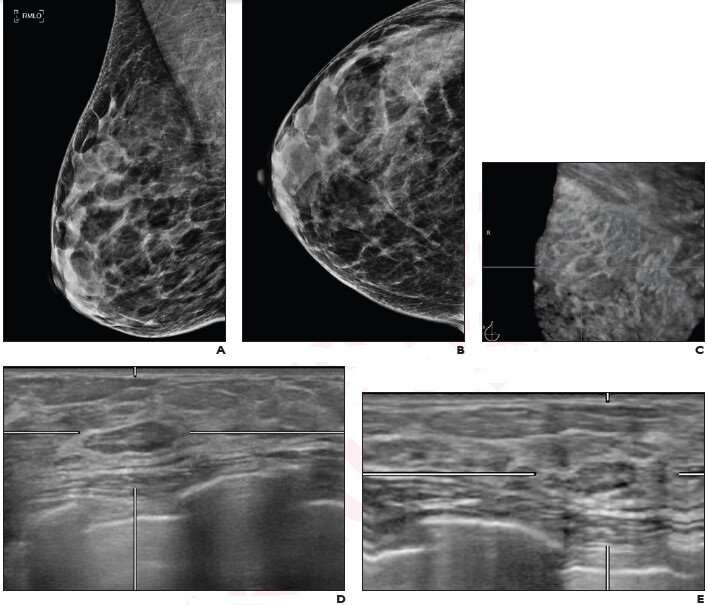Normal right mediolateral oblique (A) and craniocarudal (B) view screening mammograms demonstrate density C breasts. Coronal (C), transverse (D), and reconstructed lateral (E) views from supplemental automatic breast ultrasound (ABUS) demonstrates 7 mm circumscribed slightly hypoechoic circumscribed lesion at 11 o'clock position in right breast. Lesion was classified as BI-RADS 3. Patient has undergone yearly mammograms for 4 years following the ABUS examination with no breast cancer diagnosis. Credit: American Roentgen Ray Society (ARRS), American Journal of Roentgenology (AJR)
According to ARRS' American Journal of Roentgenology (AJR), returning to routine screening for BI-RADS 3 lesions on supplemental automated whole-breast US (ABUS) substantially reduces the recall rate, while being unlikely to result in adverse outcome.
"This prospective study supports a recommendation for routine annual follow-up for BI-RADS 3 lesions at supplemental ABUS," wrote lead author Richard G. Barr of Northeastern Ohio Medical University in Rootstown.
From August 2013 to December 2016, Barr and colleagues' prospective study (NCT02650778) enrolled patients with BI-RADS 1 or 2 on screening mammography and breast density C or D to undergo supplemental ABUS, which was interpreted as BI-RADS 1, 2, 3, or 0. For ABUS BI-RADS 1, return to routine screening was recommended, whereas ABUS BI-RADS 0 lesions underwent targeted hand-held ultrasound.
In 2,257 women (mean age, 58 years), routine follow-up of BI-RADS 3 lesions detected on supplemental ABUS screening in women with dense breasts and any risk resulted in a recall rate of 3.8% (85/2,257), biopsy rate of 0.5% (12/2,257), and positive biopsy rate of 58.3% (7/12)—with no missed cancers (95% CI, 0.0-0.86%).
Noting that ABUS can help mitigate acquisition variability by standardizing the documentation, recording, and archiving of ultrasound images from the entire breast (excluding the axilla), Barr et al. reiterated that ABUS images of similar quality can be obtained from adequately trained ultrasonographers and mammographers.
"Avoiding earlier follow-up for these probably benign lesions can be associated with substantial cost savings," the authors of this AJR article added.
More information: Richard G. Barr et al, Outcomes of Return to Routine Screening for BI-RADS 3 Lesions Detected at Supplemental Automated Whole-Breast Ultrasound in Women with Dense Breasts: A Prospective Study, American Journal of Roentgenology (2021). DOI: 10.2214/AJR.21.26180
Journal information: American Journal of Roentgenology
Provided by American Roentgen Ray Society






















